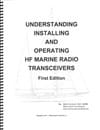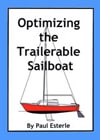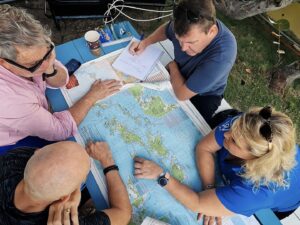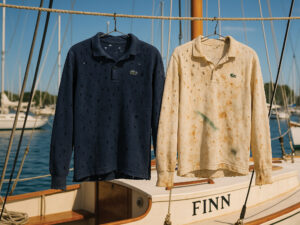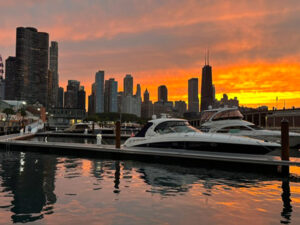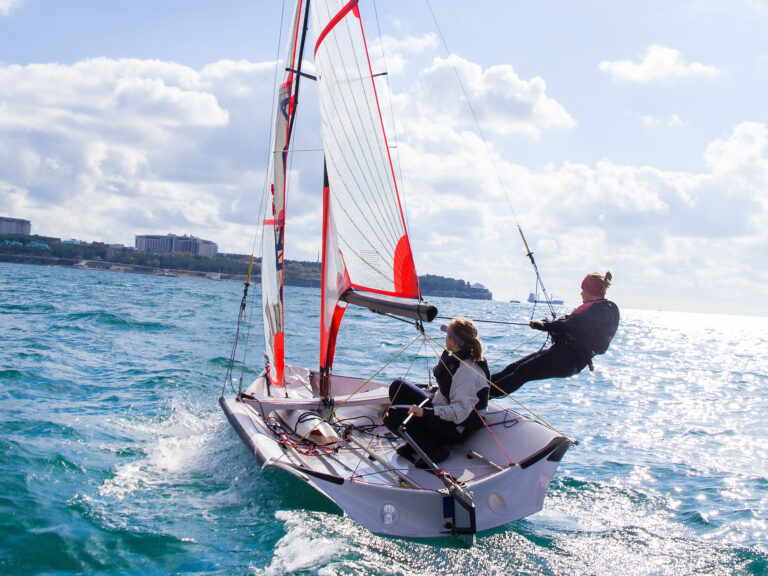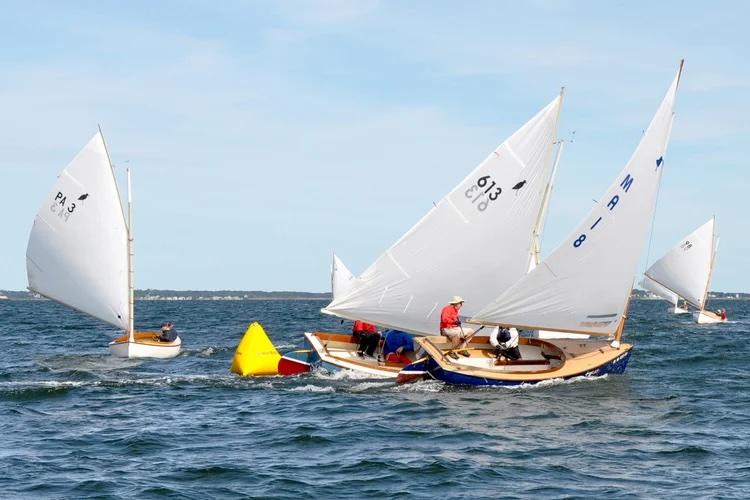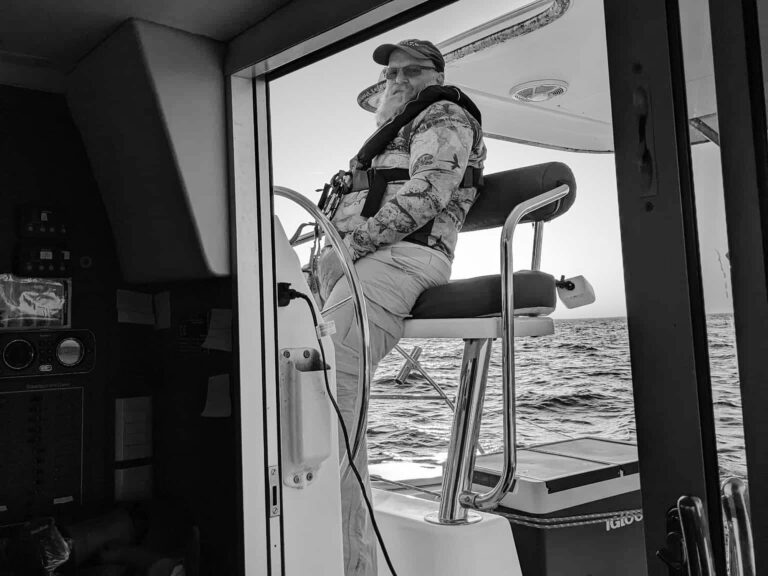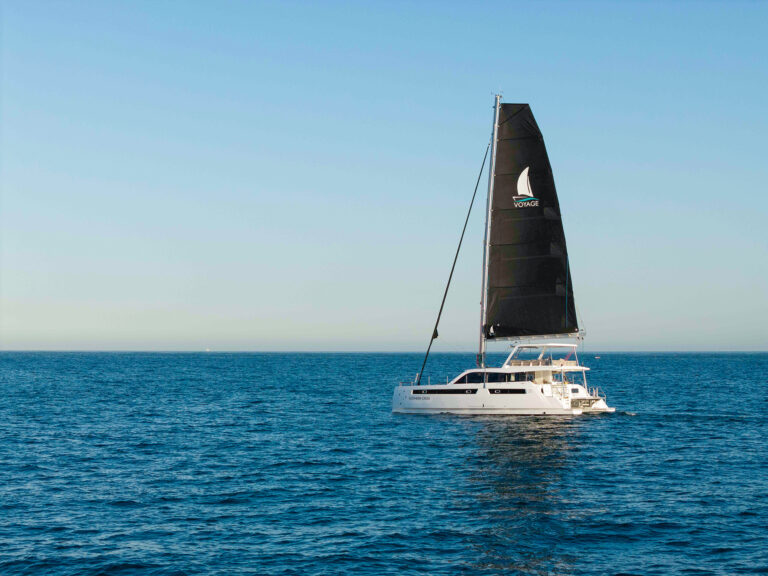
 _Hostage: A Year at Gunpoint with Somali Pirates_
_Hostage: A Year at Gunpoint with Somali Pirates_ by Paul and Rachel Chandler with Sarah Edworthy (2011; $16; Mainstream Publishing Co.). Liveaboards Paul and Rachel Chandler, who sail a 38-footer, Lynn Rival, might as well be that cruising couple a few docks over. You know—the pair you’ve known for years. But they have a miraculous adventure story to tell. Hostage is a fascinating, no-frills account of being attacked and held captive by Somali pirates for over a year. This raw, cautionary tale illuminates the reality of life-threatening situations and reveals how the couple survived and existed in bizarre confines. It’s a page-turner worth jumping into from the safety of your own cabin—far, far away from the coast of Somalia.
by Paul and Rachel Chandler with Sarah Edworthy (2011; $16; Mainstream Publishing Co.). Liveaboards Paul and Rachel Chandler, who sail a 38-footer, Lynn Rival, might as well be that cruising couple a few docks over. You know—the pair you’ve known for years. But they have a miraculous adventure story to tell. Hostage is a fascinating, no-frills account of being attacked and held captive by Somali pirates for over a year. This raw, cautionary tale illuminates the reality of life-threatening situations and reveals how the couple survived and existed in bizarre confines. It’s a page-turner worth jumping into from the safety of your own cabin—far, far away from the coast of Somalia.
-Sydney Rey


Cornell’s Ocean Atlas: Pilot Charts for All Oceans of the World by Jimmy and Ivan Cornell (2011; Cornell Sailing, $100). Seasoned voyagers know that pilot charts—the month-by-month analyses of winds and currents, rendered in easily understood “wind roses” that depict the strength and directions of each—are one of the most valuable tools for passage planning. The problem, according to author and routing guru Jimmy Cornell and his globe-girdling son, Ivan, was that much of the data in existing pilot charts, in these days of ever-changing worldwide weather patterns, had grown outdated.
by Jimmy and Ivan Cornell (2011; Cornell Sailing, $100). Seasoned voyagers know that pilot charts—the month-by-month analyses of winds and currents, rendered in easily understood “wind roses” that depict the strength and directions of each—are one of the most valuable tools for passage planning. The problem, according to author and routing guru Jimmy Cornell and his globe-girdling son, Ivan, was that much of the data in existing pilot charts, in these days of ever-changing worldwide weather patterns, had grown outdated.
With the publication of Cornell’s Ocean Atlas, that’s no longer the case. By employing the latest technology and weather information compiled via satellite over the last two decades and by quadrupling the number of roses on their clearly illustrated collection of transoceanic charts, the Cornells have not only updated a valuable resource but also substantially broadened it. For more background info, visit their website.
-Herb McCormick


Gib’s Odyssey: A Tale of Faith and Hope on the Intracoastal Waterway by Walter G. Bradley (2011; Lyons Press, $23). Gib Peters, a man who was diagnosed with A.L.S., or Lou Gehrig’s disease, at the age of 67, is determined to beat death. His true story will have you thanking your lucky stars as he sets off on a singlehanded cruise from Key West to New York to test his character against all odds. Bradley, a neurologist, chronicles Gib’s six-month voyage through the sailor’s emails to friends and family as his mind stays sharp but his body slowly deteriorates. Meanwhile, the hardship and hilarity he encounters aboard his 29-foot powerboat, Ka Ching, easily drowns out the hum of his engines. Gib will have you laughing, crying, and hugging your loved ones a little tighter. But most important, he’ll inspire you to throw off those dock lines and take on life with everything you’ve got, whether via power or sail.
by Walter G. Bradley (2011; Lyons Press, $23). Gib Peters, a man who was diagnosed with A.L.S., or Lou Gehrig’s disease, at the age of 67, is determined to beat death. His true story will have you thanking your lucky stars as he sets off on a singlehanded cruise from Key West to New York to test his character against all odds. Bradley, a neurologist, chronicles Gib’s six-month voyage through the sailor’s emails to friends and family as his mind stays sharp but his body slowly deteriorates. Meanwhile, the hardship and hilarity he encounters aboard his 29-foot powerboat, Ka Ching, easily drowns out the hum of his engines. Gib will have you laughing, crying, and hugging your loved ones a little tighter. But most important, he’ll inspire you to throw off those dock lines and take on life with everything you’ve got, whether via power or sail.
-Sydney Rey
Understanding, Installing, and Operating HF Marine Radio Transceivers by Martin Dunsmuir (2011; $30; White Squall Consulting). Setting up a reliable high-frequency system can be daunting for those of us unfamiliar with the various products and the specific cabling, antennas, modems, and software required. In this self-published manual, the author takes the mystery out of the process. Dunsmuir is an expert, and he provides regular seminars to such groups as the Blue Water Cruising Association.
This work fills in all the blanks. It begins with a section on high-frequency radio theory and quickly moves on to hardware choices, licensing, antennas, grounding, and troubleshooting. The last section is invaluable advice for solving problems offshore. The style is direct, up-to-date, and written specifically for cruisers.
-Peter A. Robson

 _Street’s Guide to the Cape Verde Islands
_Street’s Guide to the Cape Verde Islands _ by Don Street Jr. ($50; 2011; Seaworthy Publications). Don Street’s guides are the gold standard, especially when it comes to venturing off the beaten path, and this is one of his best efforts. It’s vintage Street: highly opinionated, fiercely passionate, and totally comprehensive. It has everything you need to know, plus valuable information on downwind cruising rigs and useful details once you reach your destination in the eastern Caribbean. Of particular interest are the sections on clearing in and provisioning.
_ by Don Street Jr. ($50; 2011; Seaworthy Publications). Don Street’s guides are the gold standard, especially when it comes to venturing off the beaten path, and this is one of his best efforts. It’s vintage Street: highly opinionated, fiercely passionate, and totally comprehensive. It has everything you need to know, plus valuable information on downwind cruising rigs and useful details once you reach your destination in the eastern Caribbean. Of particular interest are the sections on clearing in and provisioning.
If you like your nautical literature penned by the light of a swaying kerosene cabin lamp, this is the book for you. What’s amazing isn’t that Don was my favorite guidebook writer when I was a teenager, but that he continues to be today, when I’m in my 60s. They don’t make ’em like Don anymore. Five stars.
-Cap’n Fatty Goodlander
Last Lights: The Hand Wound Lighthouses of the Bahamian Islands by Annie Potts ($30; 2010; Florida Classics Library). Annie Potts paints an intimate portrait of the islands and its people through her personal interaction with the keepers of the last three kerosene-burning, hand-operated lighthouses in the world. The book delivers much more than the title alone suggests, including striking photography, and will enrich the experience of all who sail upon these challenging waters.
by Annie Potts ($30; 2010; Florida Classics Library). Annie Potts paints an intimate portrait of the islands and its people through her personal interaction with the keepers of the last three kerosene-burning, hand-operated lighthouses in the world. The book delivers much more than the title alone suggests, including striking photography, and will enrich the experience of all who sail upon these challenging waters.
-Tom Zydler

 _Here We Are: The History, Meaning, and Magic of GPS_
_Here We Are: The History, Meaning, and Magic of GPS_ by Jim Carrier ($3 for the e-book; 2011; New Word City). If you use or have been exposed to GPS—and who hasn’t, these days?—put this short, informative, and entertaining book on your “must read” list. Carrier, a renowned sailor, writer, and filmmaker, uses his storyteller’s skills to relate the history and evolution of GPS, the politics involved in same (including how it nearly didn’t happen), and an explanation of the technology in terms even self-proclaimed technophobes can understand.
by Jim Carrier ($3 for the e-book; 2011; New Word City). If you use or have been exposed to GPS—and who hasn’t, these days?—put this short, informative, and entertaining book on your “must read” list. Carrier, a renowned sailor, writer, and filmmaker, uses his storyteller’s skills to relate the history and evolution of GPS, the politics involved in same (including how it nearly didn’t happen), and an explanation of the technology in terms even self-proclaimed technophobes can understand.
“I believe,” he says, “that 50 years from now, historians will place GPS on the short list of inventions, alongside the clock, electricity, and the Internet, that are truly indispensible.” The same could be said for this well-focused and eminently readable
nugget of a book.
-Lynda Morris Childress

 _Voyages in Desperate Times__
_Voyages in Desperate Times__ _ by Jule Miller ($25; 2011; Good Old Boat magazine). This recording, a work of historical fiction produced by the magazine under its audio imprint, breathes life into the true tale of the American recreational sailboats and powerboats that were conscripted into the military to patrol for German U-boats in World War II.
_ by Jule Miller ($25; 2011; Good Old Boat magazine). This recording, a work of historical fiction produced by the magazine under its audio imprint, breathes life into the true tale of the American recreational sailboats and powerboats that were conscripted into the military to patrol for German U-boats in World War II.
Situated on the U.S. East Coast, the fleet, known as the Hooligan Navy, reported year-round on the presence of submarines, picked up victims of ships attacked by U-boats, and engaged U-boats in unevenly matched fights.
Narrator Spencer King capably delivers the tale, in which the author employs a style of framed narration by having a grandfather recount his experiences in the fleet to his granddaughter.
It’s a perfect way to contrast the youth of that era with the youth of today, and sailors particularly will appreciate Miller’s accuracy and attention to detail, undoubtedly a byproduct of his decades as an engineer in the aerospace industry.
-Rick Martell
Optimizing the Trailerable Sailboat by Paul Esterle ($28; 2010; available from www.lulu.com). Owners of small, trailerable sailboat for daysailing or camp-cruising will find here a compendium of simple-to-implement, ingenious yet practical ideas for maximizing enjoyment, functionality, and creature comforts on small boats. Virtually every topic from ballast to the trailer stand is covered in this work, and it’s all spiral-bound for quick, frequent reference.
-Lynda Morris Childress

 _Cooking Aboard A Small Boat—Feeding the Small-Boat Sailor_ by Paul Esterle ($18; 2011; available from www.lulu.com). Appropriately, this entire volume is devoted to the heart of any vessel, large or small—the galley, including the self-described “meat” of the book, 55 pages of satisfying, one-pot-or-pan (or bowl or cup) recipes targeted at preparation aboard a small boat. There are helpful tips on stoves and fuels, storage, tools and utensils, and shelf-stable food products. It’s a must for any trailerable-boat sailor who doesn’t want to eat like one.
_Cooking Aboard A Small Boat—Feeding the Small-Boat Sailor_ by Paul Esterle ($18; 2011; available from www.lulu.com). Appropriately, this entire volume is devoted to the heart of any vessel, large or small—the galley, including the self-described “meat” of the book, 55 pages of satisfying, one-pot-or-pan (or bowl or cup) recipes targeted at preparation aboard a small boat. There are helpful tips on stoves and fuels, storage, tools and utensils, and shelf-stable food products. It’s a must for any trailerable-boat sailor who doesn’t want to eat like one.
-Lynda Morris Childress_ _
_
_
_

 _The Sacrament of Sail: Finding Our Way
_The Sacrament of Sail: Finding Our Way _ by Matts G. Djos with Jeanine J. Djos ($16; 2011; available from Amazon). If you’re one of those who thinks sailing is a rich man’s sport, this book will change your mind. Don’t let the title fool you. This isn’t a religious tome, but a collection of heartfelt accounts by a lifelong-sailing couple of adventures on the lakes and coasts of the central and western U.S. in a succession of older, small boats. The well-written narratives reflect the authors’ magnificent obsession with sail. To paraphrase them: It all lies before you. All you must do is find a way, search out a sea, and set sail. For starters, pick up this book.
_ by Matts G. Djos with Jeanine J. Djos ($16; 2011; available from Amazon). If you’re one of those who thinks sailing is a rich man’s sport, this book will change your mind. Don’t let the title fool you. This isn’t a religious tome, but a collection of heartfelt accounts by a lifelong-sailing couple of adventures on the lakes and coasts of the central and western U.S. in a succession of older, small boats. The well-written narratives reflect the authors’ magnificent obsession with sail. To paraphrase them: It all lies before you. All you must do is find a way, search out a sea, and set sail. For starters, pick up this book.
-Lynda Morris Childress

 _Sequoiah Speeds: Memoir of a Family Afloat__
_Sequoiah Speeds: Memoir of a Family Afloat__ _ by Helen S. Warren ($18; 2010; www.amazon.com). Reluctant first mates, particularly females, will find this account of a cruising sabbatical—in which a South Carolina family takes an Endeavour 32 across the pond and back for a yearlong European adventure—both educational and informative. The author, who set out because it was her husband’s passion but admits that she’s now caught the “sailing disease,” has chronicled the cruise and day-to-day life aboard with a pre-teen and an early teen. This well-written tale is informative reading for any family considering doing the same thing.
_ by Helen S. Warren ($18; 2010; www.amazon.com). Reluctant first mates, particularly females, will find this account of a cruising sabbatical—in which a South Carolina family takes an Endeavour 32 across the pond and back for a yearlong European adventure—both educational and informative. The author, who set out because it was her husband’s passion but admits that she’s now caught the “sailing disease,” has chronicled the cruise and day-to-day life aboard with a pre-teen and an early teen. This well-written tale is informative reading for any family considering doing the same thing.
-Lynda Morris Childress

 _Family Aweigh—They Lived the Dream__
_Family Aweigh—They Lived the Dream__ _ by Michael Holt ($6 for the Kindle e-Book; 2011; www.amazon.com). It’s rare to find a nautical writer who can successfully combine good prose with laugh-out-loud wry humor, and Michael Holt succeeds brilliantly in this tale of an English family, including three teenage kids, who decide to change their lifestyle by chucking their land lives to go cruising. It doesn’t matter that their vessel of choice, Jernica (a name derived from combining the childrens’ names), is a motoryacht—the cruising trials, tribulations, and rewards are the ones that sailors know, and you’ll laugh as you enjoy every word of this family’s adventures seeking and finding a boat and their subsequent romp through the Med.
_ by Michael Holt ($6 for the Kindle e-Book; 2011; www.amazon.com). It’s rare to find a nautical writer who can successfully combine good prose with laugh-out-loud wry humor, and Michael Holt succeeds brilliantly in this tale of an English family, including three teenage kids, who decide to change their lifestyle by chucking their land lives to go cruising. It doesn’t matter that their vessel of choice, Jernica (a name derived from combining the childrens’ names), is a motoryacht—the cruising trials, tribulations, and rewards are the ones that sailors know, and you’ll laugh as you enjoy every word of this family’s adventures seeking and finding a boat and their subsequent romp through the Med.
-Lynda Morris Childress

 _Outfitting the Offshore Cruising Sailboat__
_Outfitting the Offshore Cruising Sailboat__ _ by Peter I. Berman ($20; 2011; Paradise Cay Publications). In this book, cruising sailor Peter I. Berman presents a compelling case for finding an affordable, used sailboat—and then paints a realistic picture of the work and expense that getting it blue water ready will entail. Starting with suggestions about rig and engine and concluding with tips on seaworthy accommodations and boat-buying advice, Berman walks a potential buyer through some of the many tradeoffs involved in finding just the right boat.
_ by Peter I. Berman ($20; 2011; Paradise Cay Publications). In this book, cruising sailor Peter I. Berman presents a compelling case for finding an affordable, used sailboat—and then paints a realistic picture of the work and expense that getting it blue water ready will entail. Starting with suggestions about rig and engine and concluding with tips on seaworthy accommodations and boat-buying advice, Berman walks a potential buyer through some of the many tradeoffs involved in finding just the right boat.
His best recommendation? Focus on the essentials, then go sailing.
-Mark Pillsbury


Sail Away: How to Escape the Rat Race and Live the Dream by Nicola Rodriguez ($30; 2011; Wiley Nautical). Nicola Rodriguez and her husband, John, set sail in July 2002 from their native England, and, as she says in the intro, 25,000 miles, eight years, two hurricanes, and two sons later, she wrote this book.
by Nicola Rodriguez ($30; 2011; Wiley Nautical). Nicola Rodriguez and her husband, John, set sail in July 2002 from their native England, and, as she says in the intro, 25,000 miles, eight years, two hurricanes, and two sons later, she wrote this book.
Written from the refreshing perspective of someone who chose the cruising life not as a retiree but as someone who decided to break away from the workaday world, this gorgeous book is a step-by-step guide for anyone, but especially 30-somethings and 40-somethings, thinking about taking the leap.
-Jen Brett


The Reef Set: Reef Fish, Reef Creature and Reef Coral Identification by Ned Deloach and Paul Humann ($76; 2nd ed., 2002; New World Publications). Fish-identification books are a dime a dozen, and we had several aboard. Unfortunately, every time I discovered something new, it seemed that I’d rarely find what I was looking for in a book—until I bought this trilogy. It’s designed in a way that makes it easy to identify the fish, and it includes color photos and details related to each one, including habitat and behavior. Because we love snorkeling, this set wins, hands down.
by Ned Deloach and Paul Humann ($76; 2nd ed., 2002; New World Publications). Fish-identification books are a dime a dozen, and we had several aboard. Unfortunately, every time I discovered something new, it seemed that I’d rarely find what I was looking for in a book—until I bought this trilogy. It’s designed in a way that makes it easy to identify the fish, and it includes color photos and details related to each one, including habitat and behavior. Because we love snorkeling, this set wins, hands down.
-Jan S. Irons


__
Stokes Field Guide to Birds: Eastern Region by Donald and Lillian Stokes ($12; 1996; Little, Brown and Company). When the first frigate bird soars above your boat or a brown booby lands on your wind generator, you’ll wish you had a bird book aboard. We prefer books with full color photos and information about habitat and range all in one place, and this one fills that bill.
-Jan S. Irons
__
An Illustrated Field Guide to the Birds of Panama by Ernesto Ponce and Giselle Muschett ($50; 2006; Ediciones Balboa). Easily available throughout Panama, this work describes the many birds native to that country.
by Ernesto Ponce and Giselle Muschett ($50; 2006; Ediciones Balboa). Easily available throughout Panama, this work describes the many birds native to that country.
-Jan S. Irons


__
_Usborne Spotter’s Guide: Flags of the World _by William Crampton ($8; 2003; Usborne Books). Before leaving U.S. waters, we rarely had the opportunity to puzzle over the national identity of boats we encountered. Now we seem to consult our flag book daily to identify neighbors in our anchorages.
-Jan S. Irons


__
Sport Fish of the Gulf of Mexico by Vic Dunaway ($12; 2000; Wickstrom Publications). The first time that our new trolling rod sang, we reeled in a two-foot-long fish—but was this fish edible? Dunaway’s full-color photo of the Spanish mackerel made identification easy, and the Food Value section in the description let us know that dinner, indeed, was on our hook.
by Vic Dunaway ($12; 2000; Wickstrom Publications). The first time that our new trolling rod sang, we reeled in a two-foot-long fish—but was this fish edible? Dunaway’s full-color photo of the Spanish mackerel made identification easy, and the Food Value section in the description let us know that dinner, indeed, was on our hook.
-Jan S. Irons


__
Weather: An Introduction to Clouds, Storms, and Weather Patterns ($6; 2001; Waterford Press) and Instant Weather Forecasting by Alan Watts ($13; 4th ed., 2011; Adlard Coles Nautical). These works help answer questions about clouds overhead or triple rainbows, among others. The format of Instant Weather Forecasting juxtaposes a full-page photo of a cloud with a chart listing the weather trends and timing associated with that cloud, including wind, visibility, precipitation, temperature, and barometric pressure.
($6; 2001; Waterford Press) and Instant Weather Forecasting by Alan Watts ($13; 4th ed., 2011; Adlard Coles Nautical). These works help answer questions about clouds overhead or triple rainbows, among others. The format of Instant Weather Forecasting juxtaposes a full-page photo of a cloud with a chart listing the weather trends and timing associated with that cloud, including wind, visibility, precipitation, temperature, and barometric pressure.
-Jan S. Irons


__
Weather Predicting Simplified: How to Read Weather Charts and Satellite Images by Michael Carr ($55; 1999; International Marine). This is the best reference manual for weatherfaxes, surface-analysis charts, and wind/wave charts that we’ve come across. Written by a licensed captain who’s also been a professional weather router for world voyagers, it’s useful for understanding weather forecasts, identifying unrecognized symbols on surface-analysis and wind/wave charts, and providing basic information necessary for learning to predict weather.
by Michael Carr ($55; 1999; International Marine). This is the best reference manual for weatherfaxes, surface-analysis charts, and wind/wave charts that we’ve come across. Written by a licensed captain who’s also been a professional weather router for world voyagers, it’s useful for understanding weather forecasts, identifying unrecognized symbols on surface-analysis and wind/wave charts, and providing basic information necessary for learning to predict weather.
-Jan S. Irons


__
Backyard Stars: A Guide for Home and the Road ($5; 1998; Klutz). This book answers such general questions as “What is that bright star?” Skies in the tropics are so dazzling that you’ll want to know where and when to spot planets, stars, meteor showers, and comets so you can relax on deck and take in the heavenly show.
-Jan S. Irons


__
Spanish for Cruisers: The Boater’s Complete Language Guide for Spanish-Speaking Destinations by Kathy Parsons ($32; 2nd ed., 2008; Aventuras Publishing Company). Parsons not only provides the words and easy pronunciations but also accompanying pictures. If all else fails and no one understands your Spanish, you can simply point at what you need!
-Jan S. Irons


__
Get Rid of Boat Odors: A Boat Owner’s Guide to Marine Sanitation Systems and Other Sources of Aggravation and Odor by Peggie Hall ($14; 2003; Seaworthy Publications). If the bilge perfume won’t go away, if you need a new head and don’t know which to buy, or if you don’t know when to replace your sanitation hoses, then this book is for you. We don’t need to refer to it as often as we refer to the others, but when it’s necessary, it instantly becomes the most important book aboard!
by Peggie Hall ($14; 2003; Seaworthy Publications). If the bilge perfume won’t go away, if you need a new head and don’t know which to buy, or if you don’t know when to replace your sanitation hoses, then this book is for you. We don’t need to refer to it as often as we refer to the others, but when it’s necessary, it instantly becomes the most important book aboard!
-Jan S. Irons


Atlantic Circle by Kathryn Lasky Knight ($4; 2012; available from Amazon.com). This sailing classic, first published in 1985, is now available as an e-book. Sailing has come a long way in terms of technology and creature comforts since the author’s voyages more than 30 years ago with her husband, Chris Knight, aboard Leucothea, their Bermuda 30 ketch. Nonetheless, today’s readers, especially reluctant first mates—as the author initially was—will love Knight’s rendering of transatlantic adventures, which include coastal and canal sojourns in Scandinavia and Europe. Her razor-sharp wit, keen observations, and top-notch writing provide amusing entertainment at its best.
by Kathryn Lasky Knight ($4; 2012; available from Amazon.com). This sailing classic, first published in 1985, is now available as an e-book. Sailing has come a long way in terms of technology and creature comforts since the author’s voyages more than 30 years ago with her husband, Chris Knight, aboard Leucothea, their Bermuda 30 ketch. Nonetheless, today’s readers, especially reluctant first mates—as the author initially was—will love Knight’s rendering of transatlantic adventures, which include coastal and canal sojourns in Scandinavia and Europe. Her razor-sharp wit, keen observations, and top-notch writing provide amusing entertainment at its best.
-Lynda Morris Childress


Matinicus – An Island Mystery by Darcy Scott ($15; 2012; available from Amazon.com). Sailor Darcy Scott has written a blockbuster novel that intertwines past and present on the Maine island of Matinicus. Seen primarily through the eyes of Gil Hodges, a hard-drinking visiting botanist, events unfold involving a 200-year-old journal, a restless ghost, clannish lobstermen, quirky locals, and a seductive female singlehanded sailor. All are interwoven in this tale of mystery and murder that will keep you turning pages till you reach an ending guaranteed to shock even diehard “whodunit” fans. Two more novels are in the works for an “Island Mystery” trilogy featuring the wry-witted Hodges. That’s good news, because this novel will leave you wanting more of the best male protagonist to come along since Lee Child’s Jack Reacher.
-Lynda Morris Childress


Across Islands and Oceans: A Journey Alone Around the World By Sail and By Foot by James Baldwin ($10; 2012; available from Amazon.com). In the mid-1980s, the author set sail alone in his 28-foot Pearson Triton, Atom, on a circumnavigation that took him two years to complete. It was a no-frills voyage done on a lean budget, and it was accomplished the old-fashioned way, with good seamanship, including navigation by sextant and charts and few but the real sort of bells and whistles aboard. This is the well-crafted story of a young man’s voyage of self-discovery coupled with a desire to absorb and learn from the people and cultures he experiences. He finds friendship, love, and danger in this tale, whose only detriment is its lack of an epilogue. Readers can only hope that Baldwin will provide us with one in another finely written book about his subsequent sailing as well as land-based adventures.
by James Baldwin ($10; 2012; available from Amazon.com). In the mid-1980s, the author set sail alone in his 28-foot Pearson Triton, Atom, on a circumnavigation that took him two years to complete. It was a no-frills voyage done on a lean budget, and it was accomplished the old-fashioned way, with good seamanship, including navigation by sextant and charts and few but the real sort of bells and whistles aboard. This is the well-crafted story of a young man’s voyage of self-discovery coupled with a desire to absorb and learn from the people and cultures he experiences. He finds friendship, love, and danger in this tale, whose only detriment is its lack of an epilogue. Readers can only hope that Baldwin will provide us with one in another finely written book about his subsequent sailing as well as land-based adventures.
-Lynda Morris Childress


The New Northwest Passage: A Voyage to the Front Line of Climate Change by Cameron Dueck (2012; $25; Great Plains Publications). Canadian sailor and journalist Cameron Dueck set forth for the Great White North on what appeared to be a most unlikely attempt to negotiate the Northwest Passage aboard a 40-foot cutter-rigged fiberglass monohull. Along the way, he endured crew revolts and busted gear, but his trials yielded a reward: an unparalleled portrait of radical change at the most fragile end of Earth.
by Cameron Dueck (2012; $25; Great Plains Publications). Canadian sailor and journalist Cameron Dueck set forth for the Great White North on what appeared to be a most unlikely attempt to negotiate the Northwest Passage aboard a 40-foot cutter-rigged fiberglass monohull. Along the way, he endured crew revolts and busted gear, but his trials yielded a reward: an unparalleled portrait of radical change at the most fragile end of Earth.
-Herb McCormick


South from Alaska: Sailing to Australia with a Baby for Crew by Mike Litzow (2012; University of New South Wales Press; $35). The opening quote from Joseph Conrad’s Lord Jim, “There is no life like the sea, where reality falls so short of romantic expectation,” is a fitting start for South from Alaska, a book that speaks to both sides of the brain simultaneously and without contradiction. Litzow, whose articles have appeared in CW, writes of the physical and emotional hardships of leaving it all behind and sailing from Alaska to Australia with his wife and 10-month-old child aboard Pelagic, a 25-year-old Crealock 37. He describes it in prose so beautiful, and with such a dose of self-deprecating comic relief, that you yearn to be there with them, forging ahead to realize a shared dream. And if I weren’t already cruising, his honest account would boost my own romantic notions of life at sea.
by Mike Litzow (2012; University of New South Wales Press; $35). The opening quote from Joseph Conrad’s Lord Jim, “There is no life like the sea, where reality falls so short of romantic expectation,” is a fitting start for South from Alaska, a book that speaks to both sides of the brain simultaneously and without contradiction. Litzow, whose articles have appeared in CW, writes of the physical and emotional hardships of leaving it all behind and sailing from Alaska to Australia with his wife and 10-month-old child aboard Pelagic, a 25-year-old Crealock 37. He describes it in prose so beautiful, and with such a dose of self-deprecating comic relief, that you yearn to be there with them, forging ahead to realize a shared dream. And if I weren’t already cruising, his honest account would boost my own romantic notions of life at sea.
-Michael Robertson


MoonWind at Large: Sailing Hither and Yon by Matthew Goldman (2012; Breakaway Books; $15). For those who love to relax and read while aboard and who delight in the humor of works like Farley Mowat’s The Boat Who Wouldn’t Float, this is next on your list. Goldman, an author and columnist, has compiled these essays, some previously published, others not, along with his thought-provoking illustrations. His writing is full of common sense.
by Matthew Goldman (2012; Breakaway Books; $15). For those who love to relax and read while aboard and who delight in the humor of works like Farley Mowat’s The Boat Who Wouldn’t Float, this is next on your list. Goldman, an author and columnist, has compiled these essays, some previously published, others not, along with his thought-provoking illustrations. His writing is full of common sense.
As well, the adventures of the crew of Moon Wind, a 26-foot Chris-Craft Pawnee exploring the shores of southeastern New England in search of the mystical land of Mass, where they speak a different language, will keep you turning the pages.
-Rick Martell


A Comprehensive Guide To Marine Medicine by Eric A. Weiss and Michael E. Jacobs ($16; 2nd ed., 2012; The Mountaineers Books). The authors, nationally recognized emergency medical doctors (Jacobs is also an experienced racing sailor), have honed this edition into a highly readable, practical, and insightful resource bursting with detailed advice about every possible physical malady, injury, and condition that can happen on and in the water. Advances in emergency communication, updated cardio-pulmonary resuscitation guidelines, how-to illustrations, and an expanded table of contents, index, and appendices make this manual a must-have.
by Eric A. Weiss and Michael E. Jacobs ($16; 2nd ed., 2012; The Mountaineers Books). The authors, nationally recognized emergency medical doctors (Jacobs is also an experienced racing sailor), have honed this edition into a highly readable, practical, and insightful resource bursting with detailed advice about every possible physical malady, injury, and condition that can happen on and in the water. Advances in emergency communication, updated cardio-pulmonary resuscitation guidelines, how-to illustrations, and an expanded table of contents, index, and appendices make this manual a must-have.
-Elaine Lembo


__
_Big Waves, Small Boat, Two Kids: A Family Sailing Adventure _by Katya Goodenough Gordon ($15; 2012; North Star Press). Katya Gordon, her husband, Mark, and their two young daughters set out on the cruising life with a circumnavigation of Lake Superior, then take a journey through the Great Lakes, down the U.S. East Coast, through the Bahamas, and back north again. Her story of the voyage is filled with all the ups and downs of this watery life with children, and her honesty about her family’s experience is refreshing. In the end, the Gordons discover that even if you end up where you started, the miles that pass under your keel leave an indelible mark on your soul.
_by Katya Goodenough Gordon ($15; 2012; North Star Press). Katya Gordon, her husband, Mark, and their two young daughters set out on the cruising life with a circumnavigation of Lake Superior, then take a journey through the Great Lakes, down the U.S. East Coast, through the Bahamas, and back north again. Her story of the voyage is filled with all the ups and downs of this watery life with children, and her honesty about her family’s experience is refreshing. In the end, the Gordons discover that even if you end up where you started, the miles that pass under your keel leave an indelible mark on your soul.
-Jen Brett
Looking for more good books? Find them here.




